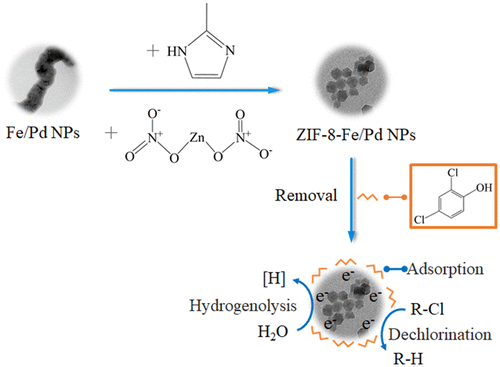当前位置:
X-MOL 学术
›
ACS Appl. Energy Mater.
›
论文详情
Our official English website, www.x-mol.net, welcomes your
feedback! (Note: you will need to create a separate account there.)
Zeolite Imidazolate Framework-8 Metal–Organic Frameworks Embedded with Bimetallic Fe/Pd Nanoparticles for Reductive Dechlorination
ACS Applied Energy Materials ( IF 5.4 ) Pub Date : 2020-07-21 00:00:00 , DOI: 10.1021/acsanm.0c01513 Long Zhou 1 , Xiaoying Jin 1 , Zuliang Chen 1
ACS Applied Energy Materials ( IF 5.4 ) Pub Date : 2020-07-21 00:00:00 , DOI: 10.1021/acsanm.0c01513 Long Zhou 1 , Xiaoying Jin 1 , Zuliang Chen 1
Affiliation

|
Bimetallic Fe/Pd nanoparticles are often used for reductive dechlorination. However, the disadvantage of using bimetallic nanoparticles is their potential aggregation, and hence reduced reactivity. To address these problems, a zeolite imidazolate framework-8 (ZIF-8) embedded with bimetallic Fe/Pd nanoparticles was successfully synthesized. Results revealed that 85.2% of 2,4-dichlorophenol was removed by ZIF-8-Fe/Pd at a pH value of 6 within 120 min and 78.8% by ZIF-8 and 46.3% by Fe/Pd, respectively. The surface composition and morphology were subsequently characterized by a variety of techniques. X-ray diffraction revealed a ZIF-8 encapsulating Fe0 with 2θ of 44.9°, while Fourier transform infrared showed that incorporating Fe/Pd did not destroy the ZIF-8 structure. Scanning electron microscopy, energy-dispersive spectrometry, and transmission electron microscopy demonstrated that Fe/Pd nanoparticles were uniformly distributed in ZIF-8 and the composite was highly crystalline. X-ray photoelectron spectroscopy indicated that Fe0 was presented inside the composite. Finally, a mechanism for the formation of ZIF-8-Fe/Pd was proposed. Testing of both the stabilization and reusability of ZIF-8-Fe/Pd indicated that ZIF-8-supported Fe/Pd nanoparticles have the potential for removing organic contaminates such as 2,4-dichlorophenol by reductive dechlorination.
中文翻译:

沸石咪唑盐骨架-8嵌入双金属Fe / Pd纳米粒子的金属有机骨架用于还原脱氯
双金属Fe / Pd纳米粒子通常用于还原性脱氯。然而,使用双金属纳米颗粒的缺点是其潜在的聚集,因此降低了反应性。为了解决这些问题,成功地合成了嵌入双金属Fe / Pd纳米粒子的沸石咪唑酸酯骨架8(ZIF-8)。结果显示,在120分钟内,pH为6的ZIF-8-Fe / Pd去除了85.2%的2,4-二氯苯酚,ZIF-8和Fe / Pd分别去除了pH值为6的78.8%和26.3%。随后通过多种技术表征表面组成和形态。X射线衍射显示ZIF-8包封Fe 02θ为44.9°,而傅立叶变换红外光谱表明掺入Fe / Pd不会破坏ZIF-8结构。扫描电子显微镜,能量分散光谱和透射电子显微镜表明,Fe / Pd纳米颗粒均匀地分布在ZIF-8中,并且复合物是高度结晶的。X射线光电子能谱表明,Fe 0存在于复合物中。最后,提出了形成ZIF-8-Fe / Pd的机理。对ZIF-8-Fe / Pd的稳定性和可重复使用性的测试表明,ZIF-8负载的Fe / Pd纳米颗粒具有通过还原脱氯去除有机污染物(例如2,4-二氯苯酚)的潜力。
更新日期:2020-07-21
中文翻译:

沸石咪唑盐骨架-8嵌入双金属Fe / Pd纳米粒子的金属有机骨架用于还原脱氯
双金属Fe / Pd纳米粒子通常用于还原性脱氯。然而,使用双金属纳米颗粒的缺点是其潜在的聚集,因此降低了反应性。为了解决这些问题,成功地合成了嵌入双金属Fe / Pd纳米粒子的沸石咪唑酸酯骨架8(ZIF-8)。结果显示,在120分钟内,pH为6的ZIF-8-Fe / Pd去除了85.2%的2,4-二氯苯酚,ZIF-8和Fe / Pd分别去除了pH值为6的78.8%和26.3%。随后通过多种技术表征表面组成和形态。X射线衍射显示ZIF-8包封Fe 02θ为44.9°,而傅立叶变换红外光谱表明掺入Fe / Pd不会破坏ZIF-8结构。扫描电子显微镜,能量分散光谱和透射电子显微镜表明,Fe / Pd纳米颗粒均匀地分布在ZIF-8中,并且复合物是高度结晶的。X射线光电子能谱表明,Fe 0存在于复合物中。最后,提出了形成ZIF-8-Fe / Pd的机理。对ZIF-8-Fe / Pd的稳定性和可重复使用性的测试表明,ZIF-8负载的Fe / Pd纳米颗粒具有通过还原脱氯去除有机污染物(例如2,4-二氯苯酚)的潜力。





















































 京公网安备 11010802027423号
京公网安备 11010802027423号